Mussolini’s Hometown Can’t Figure Out How to Quit Him
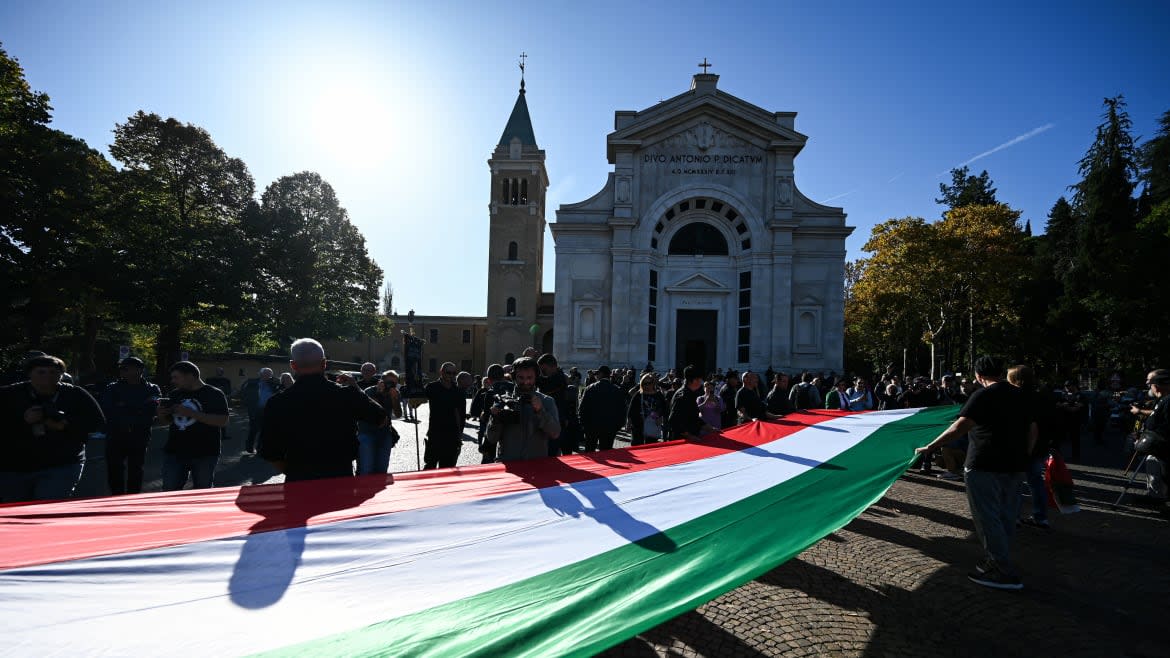
How do you solve a problem like Predappio?
This small town in the hills of northern Italy where Mussolini was born in 1883 remains something of an enigma. The previous mayor called it the “Chernobyl of Italy”—a place too toxic to touch. It plays host to large neo-fascist rallies, souvenir shops selling Mussolini trinkets and the tomb of Il Duce himself, which lies in a crypt in the town’s municipal cemetery. All of this co-existing alongside 6,000 citizens in one of Italy’s most historically left-wing strongholds.
Since the end of World War II, Predappio’s citizens have routinely elected mayors from the political left. This was until 2019 when, as part of a right-wing surge across Italy that eventually brought Giorgia Meloni to power, Predappio elected its first right-wing mayor since the death of its most famous son.
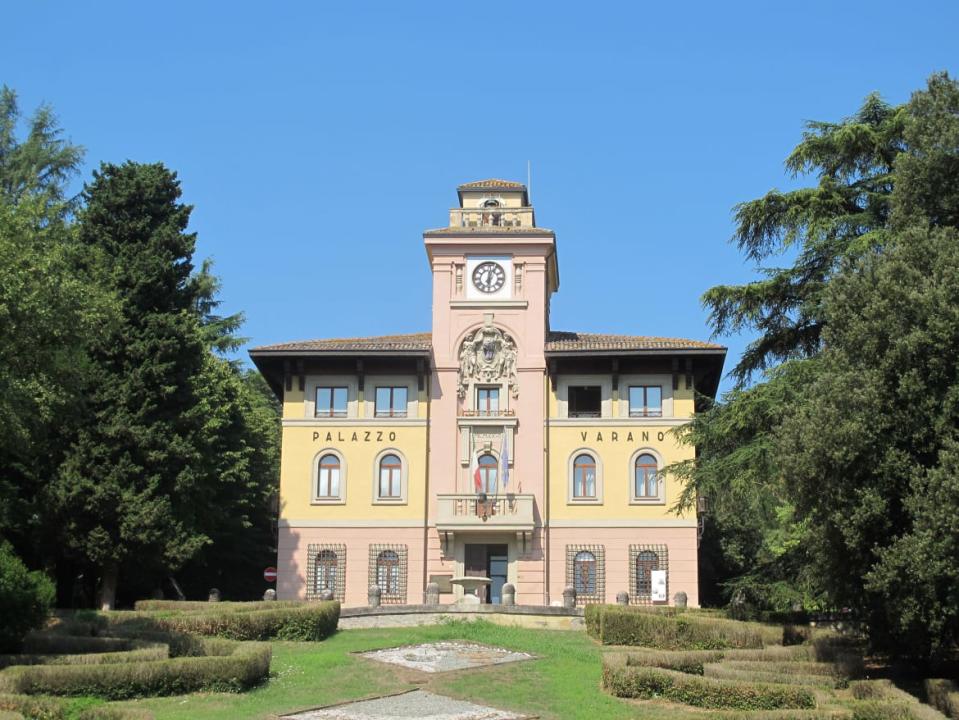
The town hall of Predappio, Palazzo Varano, in Italy. The Italian dictator Mussolini was born in the town in 1883, and for a time he lived in this building, which was once a school.
At Palazzo Varano, Predappio’s striking town hall, where Mussolini lived for a time as a child, I met with Roberto Canali, the new mayor. He was charming, earnest, almost guileless in a way that’s difficult to feign. He talked at length about his love for Predappio, its Sangiovese wine, its festivals and its ancient Roman origins. He winced slightly when I brought up its most famous local son.
“Every time something fascist happens anywhere in Italy, journalists phone me up for a response. It happened recently with the rally in Rome. The next day I was inundated with calls. Why should I, as the mayor of a small village in northern Italy, be forced to comment? I’m tired of it. Some people still think we’re living in the 1920s here.”
His weariness was understandable. Much of his time, he told me plaintively, is spent dealing with the ongoing damage and compensation over last year’s devastating floods, which severely damaged Predappio and its constellation of villages.
He took a dim view of the carnivalesque fascist rallies which take place here every year on Italian fascism’s three most important anniversaries: Mussolini’s birthday, Mussolini’s death day, and the March on Rome—the bloodless coup that brought Mussolini to power in 1922.
“I don’t like seeing them. If you come to Predappio, you should leave your black shirts at home. Dress as you would in your own town. We are hospitable people but we deserve respect.”
But should they still be allowed to continue?
“It’s a police matter,” he said bluntly. “If they’re not illegal, then we can’t ban them. Anyway, these marches are organized and attended by outsiders. No one from Predappio actually joins them. But somehow we’re the ones who get castigated.”
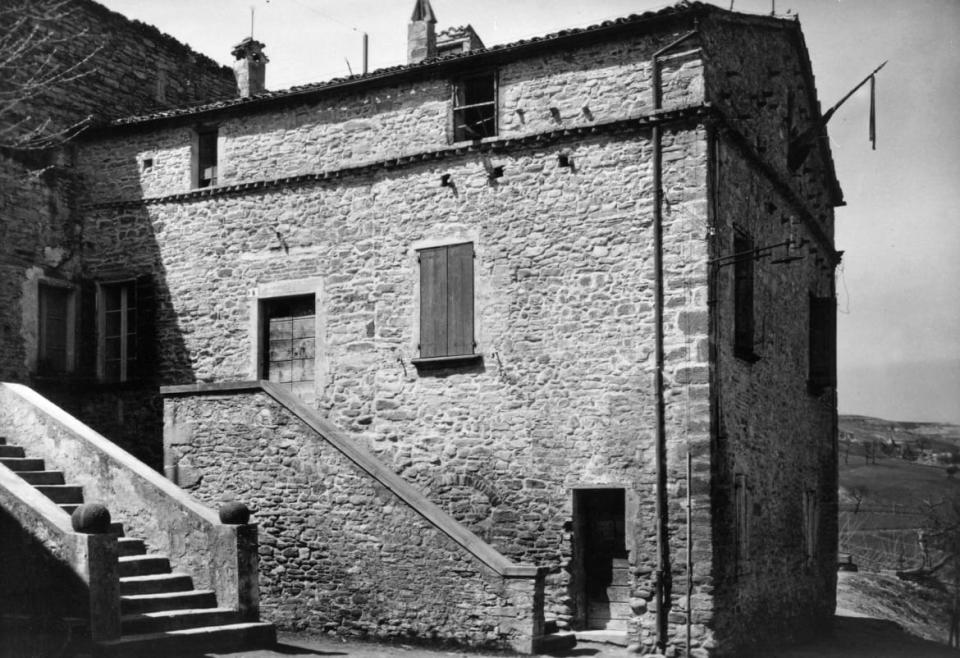
The childhood home of Mussolini in Predappio, Italy.
When Mussolini was born here in 1883, Predappio was an unassuming farming village in a rural, undeveloped corner of Italy, which had unified as a country just 22 years earlier. After he came to power in 1922, he returned to the village and inaugurated Predappio Nuova, a grand, futuristic utopia built around the farmhouse where he was born. The idea was twofold: look at the humble origins of your leader, the straw bed where he slept, the schoolhouse where his working-class mother taught. And now look at how he is transforming the country, emancipating the downtrodden and leading Italy into a glorious, developed future.
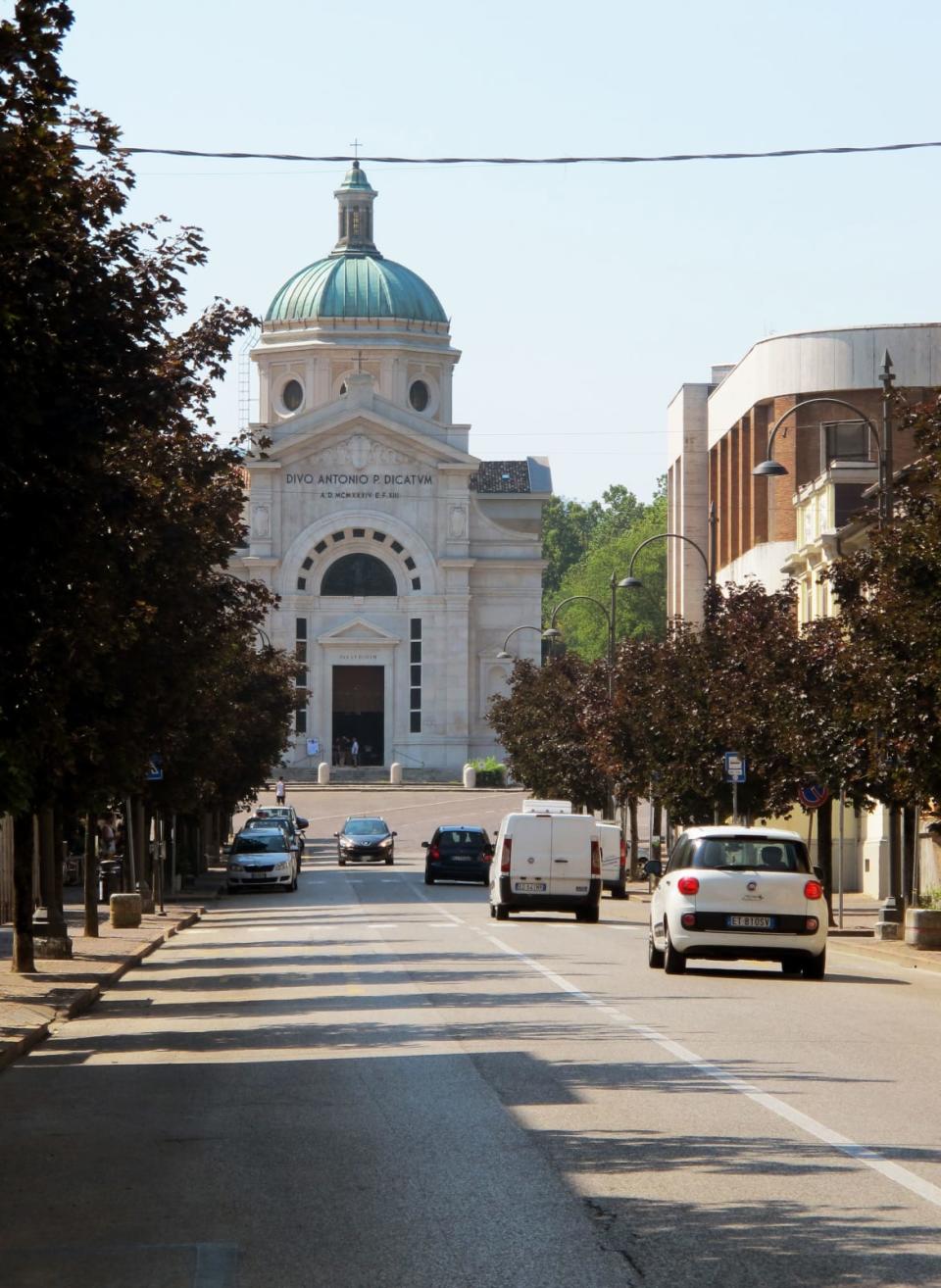
The church of S. Antonio in a central square of Predappio. The church was consecrated in 1934.
The story is interesting, but the results are not. Unlike the more beguiling and impressive “foundation cities” of the 1930s such as Tresigallo, Sabaudia and EUR, Predappio feels unfinished and glibly monumental; a boulevard in search of a city. Its roll call of buildings, lined up in military formation, are striking, eclectic, occasionally attractive, some indicative of the prevailing trends in modernism, others appearing like Art Nouveau townhouses bussed in from the 19th century. The boulevard ends at the town’s church, which features the inscription E.F. XIII, indicating that it was built in the 13th year of fascist rule. (In one of his more messianic moments, Mussolini had decided to reinvent the calendar so that 1922—the year he came to power—now became Year 1. This new chronology frequently graced public buildings.)
Mussolini’s Last Laugh: How Fascist Architecture Still Dominates Rome
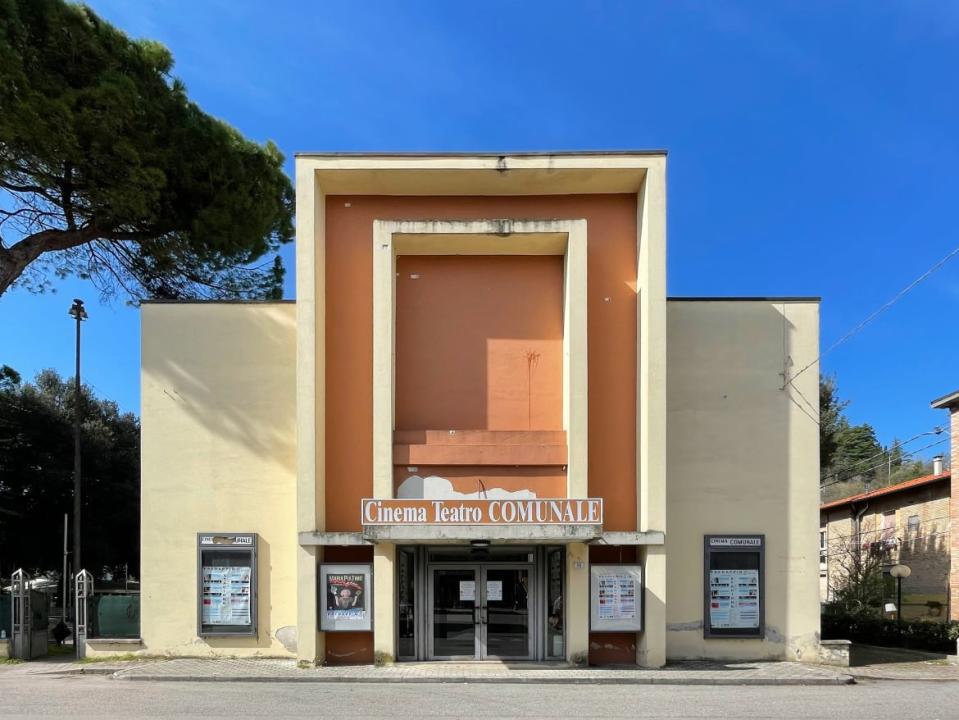
An example of the architecture found in Predappio, Italy. This is the municipal movie theater.
Just opposite is the former local branch of the Fascist Party, a hulking leviathan of a building that has mostly sat derelict since the end of the war. This was the intended site of a Museum of Fascism, the big idea of the previous mayor, who thought it would bring a sense of closure to the town. The project was attacked by both the right and the left in Italy, the latter believing it would further glamorize Predappio as the cradle of fascism, rather than just an incidental moment in fascism’s pan-Italian story. Ultimately, the project was killed by the new mayor.
“We are a small town with a small economy and we cannot take on the huge responsibility of Italy’s only Museum of Fascism all by ourselves,” said Canali. “If we had the help of the central government and large institutions, then that would be different. But that has not been forthcoming. Instead, I think we should focus on architectural tourism. We have some amazing buildings from the interwar period. We recently put on a successful exhibition about the architecture of the town in Mussolini’s birth house.”
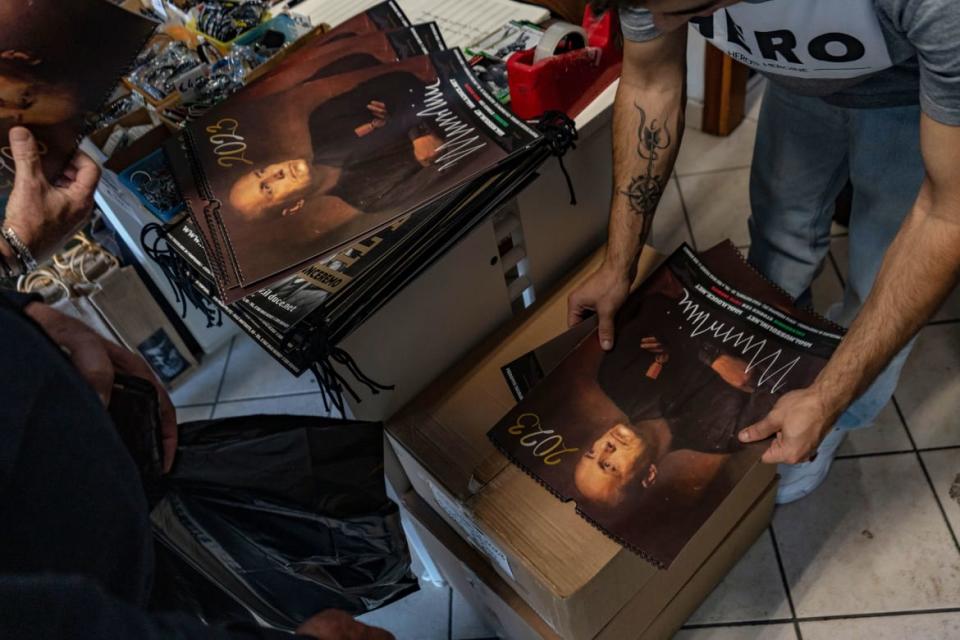
Calendars with Benito Mussolini’s image on sale in a shop selling souvenirs from the fascist and Nazi period, Oct. 30, 2022 in Predappio, Italy.
Can tourism in Predappio ever be neutral? The town hosts two Mussolini souvenir shops; both unexpectedly large, one of them taking up the commercial space of two separate buildings. I had half-expected them to be flogging tacky mementos in the name of “historical curiosity” but no, this was overtly and unambiguously fascist merchandise. Mussolini calendars, Mussolini wine, Mussolini pasta(?), Mussolini busts, black shirts, baby clothes, truncheons, fasces, eagles, cigarette lighters and ashtrays. One shop offered a special deal: 10 anti-communism bracelets for only €5 ($5.50). The stores were plastered with flyers for various local neo-fascist groups in Italy, all of which seem to have adopted the aesthetics of early-2000s metalcore bands.
The fact that both shops feel confident enough to be open on a Friday morning in February suggests that Predappio is more than just a three-times-a-year destination for a certain kind of tourist.
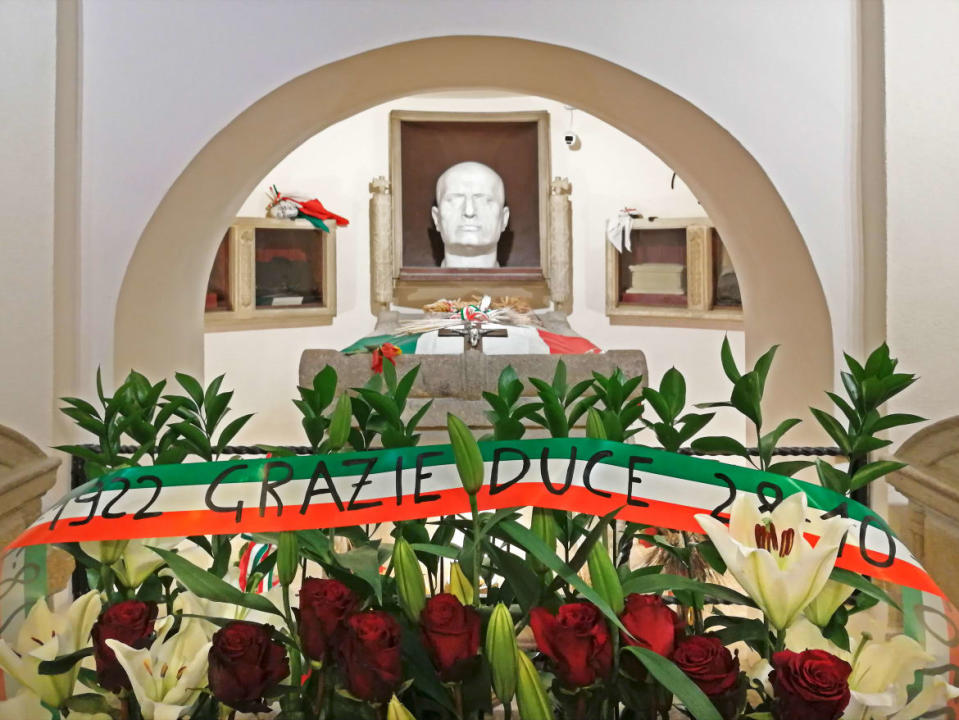
The Mussolini crypt in Predappio, Italy.
Likewise, the Mussolini family crypt is open and I’m one of several visitors squeezed into an underground cavern where various members of the clan are buried. The big draw is the tomb of the man himself, draped in a large Italian flag and a sash that says, “GRAZIE DUCE,” followed by the date of the March on Rome. A Trunchbull-ish custodian leads approving tours of the space to wide-eyed pilgrims but scolds me for trying to flick through the crypt’s guestbook. It’s estimated that up to 100,000 people visit Mussolini’s tomb every year.
“We’re just an ordinary town” is a common refrain heard in Predappio. But visiting the town, it comes across more as a cry for help. The paradox of Predappio is that it is an extraordinary place filled with people who desperately want it to be ordinary. The result is a kind of netherworld: an entire town constructed as fascist propaganda now condemned for eternity to be fascism’s theme park.
“The residents of Predappio know as well as you and I that there’s quite a lot that’s weird and distinctive about their hometown,” said Paolo Heywood, assistant professor of anthropology at the University of Durham and author of Burying Mussolini: Ordinary Life in the Shadows of Fascism. “They know that it’s not usual to have to muscle your way past a group of singing fascists to get to the bar to order a coffee. They know it’s not ordinary to be asked for directions to Mussolini’s tomb by tourists dressed in black while on your way to do the shopping. The mayor knows that other small-town mayors aren’t frequently contacted by journalists wanting them to comment on fascism. But because they don’t want that to be so, then they try hard to live as if it isn’t so. And that’s the way of dealing with it. That’s the attitude that you’re supposed to have towards this stuff because touching it brings no good, basically, to anybody ever.”
Heywood has family links to Predappio and has lived in the town trying to understand how ordinary life carries on in the shadow of Mussolini. Like Canali, he agreed that public opinion in traditionally left-wing Predappio is largely against the fascist rallies that turn the town into a raging cauldron of discourse three times a year.
“I think it’s a resigned sense that there’s absolutely nothing they could do about it. Again, in collective memory and experience, they know that in 1957, when these things first started, the police tried to arrest people. It didn’t make any difference. They know that in the 1960s and ’70s, left-wing militants came and beat people up and tried to stop them coming that way. There was even a bomb set off in the crypt. It didn’t make any difference,” he said. “If anything, that just made life more inconvenient and uncomfortable for locals. Since the ’80s, it’s basically been peaceful. What is there to do about it, from their point of view? They have no experience of any legal recourse.”
The World Is Tearing Down Racist Monuments but Not in Italy
So how can Predappio ever move on?
“I think what would be important to bear in mind for anybody thinking about solutions is that Predappio exists in the wider national and historical context. It’s not an island untouched by post-war history or by national attitudes to these phenomena,” Heywood explained. “That’s the way in which it’s often conceived of by people on the right, who think it’s this weird Disneyland place that they can visit to remember when everything was great, and people on the left who loathe it and think it condenses everything poisonous and awful about Italian attitudes to fascism. But it isn’t that. It exists in symbiosis with wider issues including broader, systemic failures in the de-fascistization process since the war. And so in that sense, I think it’s reasonable that locals are somewhat suspicious of ideas that are going to treat them as an isolated case that just needs a special magical fix and then everything will be alright.”
The irony is that all discussions about Predappio never seem to escape the trap of thinking of it—not as a real town with real people—but as a symbol, a problem, a Rorschach test.
Mussolini created Predappio to give himself a sense of immortality. The tragedy is that he succeeded, and no one is quite sure how to deal with that.
Get the Daily Beast's biggest scoops and scandals delivered right to your inbox. Sign up now.
Stay informed and gain unlimited access to the Daily Beast's unmatched reporting. Subscribe now.


